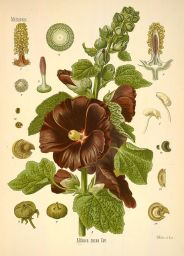Mellow Mallows
By Audrey Stallsmith

For want and famine they were solitary; fleeing into the wilderness in former times desolate and waste. Who cut up mallows by the bushes, and juniper roots for their meat.
Job 30:3-4
According to mythology, mallows were the first gift sent to earth by the gods to prove that they had man's best interests at heart.
These flowers--which include hollyhock, hibiscus, and malva plus the less well-known abelmoschus, callirhoe, lavatera, and sidalcea--are, indeed, an extravagant present. Although most are big and beautiful, they have easy-going temperaments.
The majority of mallows are found in tropical climates, but the ones that do survive here in Zone 5 have proven quite adaptable. They self-sow prolifically, and can become a nuisance. Shakespeare, in fact, mentions mallows in the same breath with such weeds as nettles and docks. Their flattish, disc-shaped seed pods are commonly called "cheeses."
The wild marshmallow is the ancestor of the hollyhocks. Its roots are, as Culpeper put it, "full of a slimy juice, which, being laid in water, will thicken, as if it were jelly." In the early 19th century, French and German candymakers whipped, sweetened, and molded that sap to create the familiar confections named for the plant.
There is, of course, no real marshmallow root in marshmallows these days. Gelatin has replaced it. But the plant has more to offer than candy.
The ancient Romans and Egyptians boiled, fried, and ate the roots as vegetables. (Culpeper recommends cooking them with parsley or fennel roots.) Uncooked, they were the teething rings of olden days, since they soothed a baby's gums as he gnawed. Marshmallow also relieves colds, ulcers, and kidneystones, as well as soothing all kinds of inflammations.
In the Language of Flowers, mallow stands for the "mildness" which is one of the clan's biggest assets. The family name, Malvaceae, derives from malake or "soft." Althea, which has been adapted to the modern alcea, comes from the Greek altho, which means "to cure."
Because they are "good" plants, mallows are also supposed to repel witches and break up the "wicked gatherings that be engendered in a man's body." Hollyhock actually derives from holi ("holy") and hoc ("mallow"), and stands for "ambition" or "fecundity." It may, in fact, have been brought to Europe from the Holy Land, as so many flowers were, after the Crusades.
Any daring souls who want to tread hot coals might be well advised to paint their soles first with a mixture of egg white and mallow sap. It's supposed to protect the skin from fire!
The hollyhock is a mainstay of cottage gardens. One of Maugham's characters thinks wistfully of "the dear flowers which bloom in all men's hearts, of the hollyhock and the red and white rose which is called York and Lancaster, and of love-in-a-mist and Sweet William, and honeysuckle, and larkspur, and London Pride. . ." In this country, however, hollyhocks often served as a pretty screen for outhouses!
The natives of India grow Hibiscus canabinis, also known as Mahl-stick, for its fiber. From the calyxes of Hibiscus sabdariffa, otherwise called roselle or Red Sorrel, they make exotic jellies and tarts. And they shine their footwear with the blooms of Hibiscus rosa-sinensis, alias Shoe-flower. In the Language of Flowers, the bold hibiscus stands, strangely enough, for "delicate beauty."
The abelmoschus, or musk mallow, is popular in India too. Its Latin name derives from the Arabic habb-ul-mushk ("grain of musk"), and its amber seeds scent perfumes and flavor coffee. The finger-sized fruit of Abelmoschus esculentus, better known as bandicoy, bendy, or bindy is eaten as an Oriental vegetable. In this country, we call it okra or gumbo. It was apparently brought to the Americas by slaves from West Africa, who knew it as nkruma.
Although many of the tropical hibiscuses are too tender for Zone 5, they overwinter surprisingly well indoors, if they are cut back to a reasonable size first. Like other woody tropicals such as fuchsia and lantana, they will often drop a large percentage of their leaves when they are brought indoors.
But, don't panic! The plants aren't dying, just deciding how many leaves they can afford to keep in the new lower light levels. If given a sufficiently sunny position, your tropical hibiscus may even bloom off and on during the winter, as my many-years-old 'Kona' does. This is one plant, in other words, that docilely adapts to what it cannot change!
So, despite their often towering height and showy flowers, the mallows aren't vain or temperamental enough to be the gift of mythological deities. Rather, they must come from the God who has proven his love for man to be enormous!
Alcea rosea image is from Kohler's Medizinal-Pflanzen, courtesy of the Missouri Botanical Garden








